
11 Reasons To Buy A Shower or Bath Water Filter
June 10, 2021 2:35 pm Leave your thoughts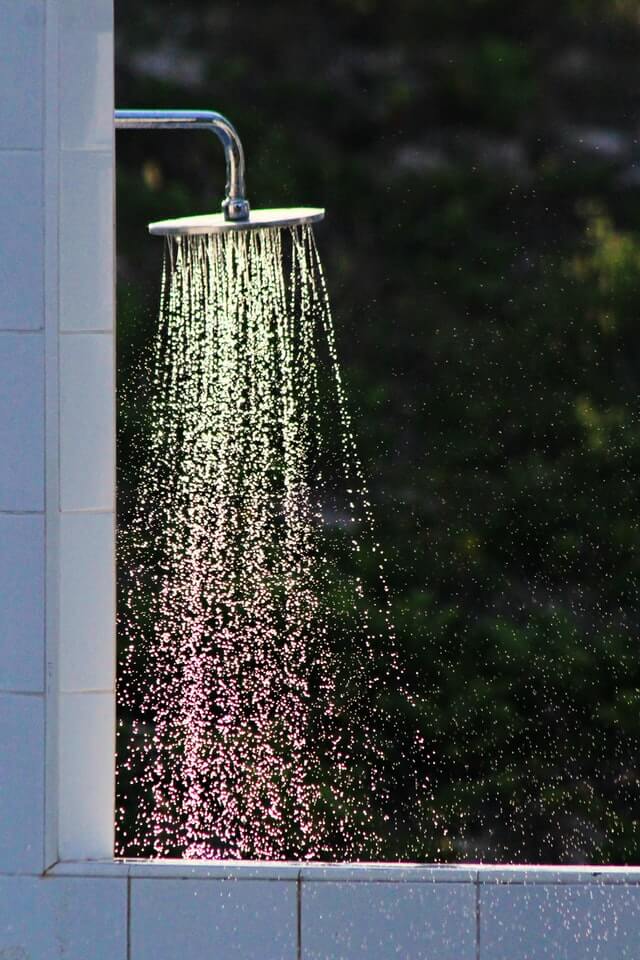
Most Australians already know the importance of drinking clean filtered water. But did you know that the quality of the water you shower and bath in can also affect your health?
Unfiltered shower water can contain a variety of contaminants including chlorine, pesticides, chloramines, trihalomethanes, dissolved minerals, heavy metals, and bacteria.
These substances can make showering a less pleasant experience as they can make your water smell or taste terrible. Chemicals like chlorine can also dry out your skin and hair, as well as worsening conditions like eczema and rosacea — especially in young children and babies.
If the water quality in your area is quite poor, you may even be exposed to contaminants which have a serious impact on your health and increase the risk of chronic health disorders.
The solution to dealing with these contaminants is filtration. Shower water filters can dramatically reduce the number of contaminants in your water, making showering a safe and more enjoyable experience.
Here is a little more information on how shower filters work and 11 reasons why you should filter shower water. If you are already interested in buying a shower filter, jump to the section on the best shower water filters in Australia.
Products Mentioned In This Guide
- Sprite Solid Brass Chrome High Output Shower Filter
- Omnifilter Shower Soft SF100 Shower Filter System using KDF
- Sprite Complete Shower Filter with Wall Fitting, Hose & Hand Held Filter
- Sprite Hand Held Sprite Shower Filter Attachment
Contents
What Could Be In Australian Shower Water?
How Do Shower Water Filters Work?
11 Reasons Why You Need A Shower Water In Australia
Considerations When Choosing A Shower Water Filter
The Most Popular Shower Water Filters In Australia
Frequently Asked Questions
– Do shower filters work for hard water?
– Can shower filters remove fluoride?
– What kinds of skin conditions can shower filters help with?
– Will a shower filter improve my hair?
– Are shower filters hard to install?
– Are Shower Water Filters Safe?
What Could Be In Australian Shower Water?
Although Australia has high quality water by international standards, it can still contain a wide range of natural and man-made contaminants, including:
- Chlorine
Most Australian towns and cities have chlorine added to their water supply to kill bacteria, viruses, and protozoa. Although it does a great job of killing these contaminants, its use does come with several downsides. The most noticeable downside is the negative impact on the taste and smell of your water. Showering in chlorinated water can also impact your health and physical appearance in several ways (more on that below). - Chloramines
Chloramine is a chemical compound generated when chlorine combines with ammonia. It has a very a strong chemical smell. - Trihalomethanes
Trihalomethanes are chemicals created when chlorine interacts with rotting organic matter. There is some evidence to suggest that trihalomethanes are dangerous. Researchers believe they can increase the risk of bladder cancer, colorectal cancers, and miscarriage in pregnant women. - Cyst Parasites (Cryptosporidium and Giardia) and Bacteria
If you are using unchlorinated water from a bore, tank, river, stream, or dam, it may contain parasitic cysts like cryptosporidium and giardia. They can make you ill if ingested and should be removed to make your water safe. Untreated water may also host bacteria including Escherichia coli (e-coli) and Coliform. - Heavy Metals
Heavy metals like lead, arsenic, cadmium, and copper can be introduced into your water supply via natural factors (erosion, natural mineral deposits) or manmade factors (corroding pipes, pollution). Ingesting heavy metals can be very dangerous. - Rust
Although rust isn’t particularly dangerous to consume in low doses, it will discolour your drinking water and can stain your clothing. - Fluoride
Most Australian councils will add fluoride to the water supply to improve the dental health of residents. However, there is some evidence to suggest that high levels of fluoride may be unsafe and several small-scale studies have shown a potential link to certain cancers. - Scale Producing Minerals
Some parts of Australia have water that is high in scale producing minerals like calcium and magnesium. These minerals can cause staining in your shower and may cause your shower head to clog up. - Chemical and pesticides
Your local water supply may be contaminated by potentially dangerous chemical contaminants including Poly and Perfluoroalkyl Substances (PFAs), Volatile Organic Compounds (VOCs) and nitrate/nitrites.
How Do Shower Water Filters Work?

Shower water filters can reduce some of the contaminants listed above. Most products work using one or more of the following approaches:
Mechanical Filtration
The media in the filter operates like a sieve, blocking contaminants which are larger than the holes in the filtration media. This is a simple and effective way to block sediment, algae, dirt, and metal particles. Sediment filters can be made from a variety of materials including food grade polypropylene and metal mesh.
Absorption Filtration
This type of media can absorbs contaminants like a sponge. The most common material used for absorption filtration in shower filters is Granular Activated Carbon (GAC). It contains microscopic pores which can trap chlorine, metal, sediment, chemicals, and other contaminants. After several months, the carbon pores become full and the filter will need to be replaced.
Electron Exchange (Redox Filtration Media)
Some forms of filtration media will use electrochemical reactions to reduce contaminants. These products will exchange electrons with certain contaminants in water, turning them into elements that are harmless for humans. This chemical process is called an oxidation/reduction (redox) reaction.
KDF55 is the most common form of media which uses the redox process (more on KDF55 in a moment). These types of materials are sometimes called Redox Filtration Media.
Filtration Media Used In Shower Water Filters
Most Australian water filters will contain Granular Activated Carbon (GAC), Kinetic Degradation Fluxion (KDF), and/or Chlorgon. Here is a short summary of what these materials do to your shower water:
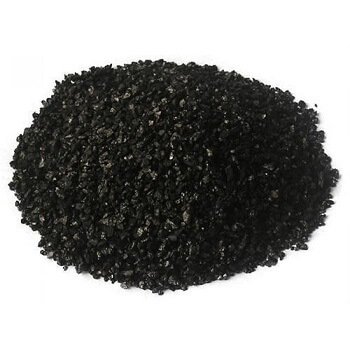
Granular Activated Carbon (GAC)
Granular activated carbon is a type of carbon which is capable of absorbing chemicals from water. It can also act as a mechanical filter, which traps sediment, rust, dirt, metals, and other contaminants.
It is called ‘activated’ carbon because it has been processed to create additional pores and a greater surface area. These pores are capable of absorbing certain chemicals, including chlorine.
Carbon needs contact time to absorb chemicals, so it isn’t used in shower filters as much these days. Most filters will now use KDF, however, some cheaper shower filters will still contain some GAC.
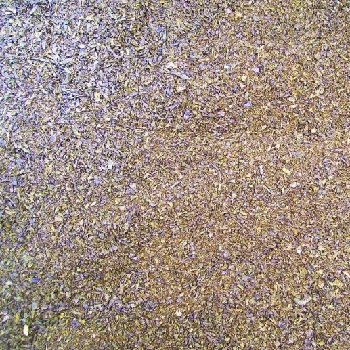
Kinetic Degradation Fluxion (KDF)
KDF is a form of Redox Filtration Media which uses electron exchange to remove contaminants from water.
KDF 55, which is made from copper and zinc, is the most common form of KDF media used in water filters. It can remove a wide range of contaminants from fast flowing hot water which makes it ideal for filtering shower water.
KDF 55 reduces dissolved chlorine in water by changing it into water-soluble chloride ions (which are harmless to humans). It can also reduce certain heavy metals, algae, fungi and scale.
An additional benefit of using KDF55 is that it has a bacteriostatic function, which means it can inhibit bacterial growth.
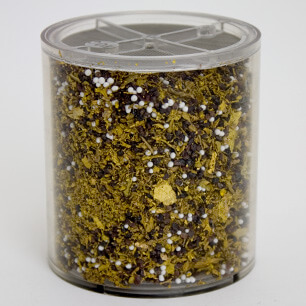
Chlorgon
Chlorgon is a proprietary blend of mineral salts developed and patented by David Farley, who is the CEO of Sprite Industries, Inc. It can convert free chlorine and certain combined chlorine’s, (including sodium hypochlorite commonly used in swimming pools), into a harmless chloride. Chlorgon works well in hot water and doesn’t inhibit water flow, which makes it ideal for use in a shower.
11 Reasons Why You Need A Shower Water Filter in Australia
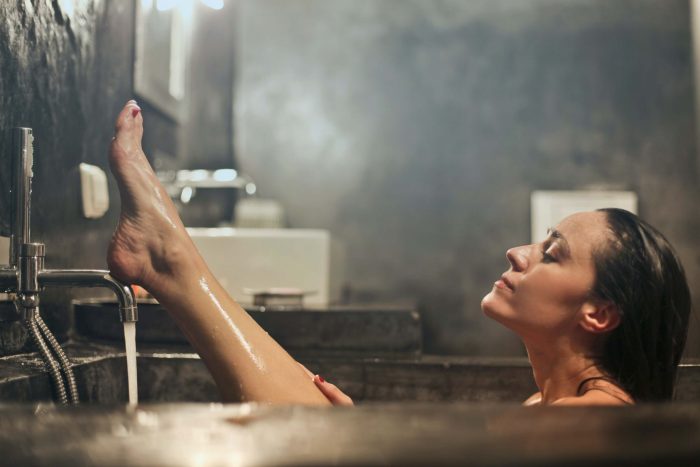
Now that you know how a shower water filter works, here are a few reasons to get one:
1. Reduce Your Exposure To Chlorine
Most towns and cities in Australia will treat their water with chlorine to kill bacteria, protozoa, and viruses. It is a simple and effective way to make water safe for drinking. However, there are several downsides to showering in chlorinated water, including:
- Dry, brittle, or discoloured hair
Chlorinated water can strip out natural oils which keep your hair looking great. This leaves you with dull and brittle hair which is difficult to manage. If there are very high levels of chlorine in your water, it can even discolour your hair, giving it a green tinge. Some people also experience a flaky or itching scalp due to showering in chlorinated water. - Dry skin
Chlorine will also strip beneficial bacteria and protective oils from your skin. It can be quite harsh and often leads to skin irritation. Exposure to hot chlorinated water is particularly bad, as it can make your skin itchy and very dry. This drying effect can contribute to premature ageing. - Red eyes
If you have ever spent time in a swimming pool, you know how much it can irritate your eyes. The same goes for showering in chlorinated water. If you spend enough time in the shower, it will also cause extreme redness and a burning sensation.
2. Avoid Eczema and Rosacea Flareups
If you have a pre-existing skin condition like eczema or rosacea, showering in chlorinated water may be one of the worst things you can do.
The harsh drying action of chlorine can cause eczema or rosacea or flareups which can dramatically impact the condition of your skin.
We have had several customers say that showering in filtered water was the single best change they have made for treating their skin condition.
3. Reduce Chloroform Exposure
There are several forms of trihalomethanes produced when chlorine contacts decaying organic matter in waterways. One of the most dangerous forms is chloroform.
If you are on town water, some of the chloroform present in the water will be vaporised, causing you to breathe it in. This can make you feel lethargic, disoriented, or dizzy.
Even worse, long term exposure to chloroform may even cause cancer. The U.S. Department of Health and Human Services has said that chloroform is “reasonably anticipated to be a human carcinogen”. Not the type of material you want to bathe in or inhale.
4. Limit Bacteria Growth
Bacteria thrives in dark, wet and humid environments – like the interior of a shower head. When you have a shower, you may find yourself being exposed to some of this bacteria as it is forced out by shower water.
If you are on tank water, you may also have bacteria in your tank, gutters, and plumbing.
Shower filters with GAC can absorb larger clumps of bacteria while KDF has a natural bacteriostatic function (inhibiting bacteria).
5. Limit Exposure To Other Chemicals
Many types of chemicals can make their way into municipal water supplies and water tanks. This can include pesticides from agricultural overspray, fluoride, Teflon, and polyfluorinated chemicals (PFCs). Having a shower water filter in place with activated carbon or KDF can reduce some of these chemical contaminants.
6. Avoid Heavy Metal Exposure
Toxic heavy metals like lead, mercury, and arsenic can enter the water supply from natural or manmade sources. In high doses, these metals can increase the risk of many different health conditions including cancer, skin lesions, cardiovascular disease, birth defects, poor cognitive development, and diabetes.
KDF filters can reduce the levels water-soluble heavy metals in your water supply, potentially helping you avoid some very dangerous health problems.
7. Enjoy Cleaner Water
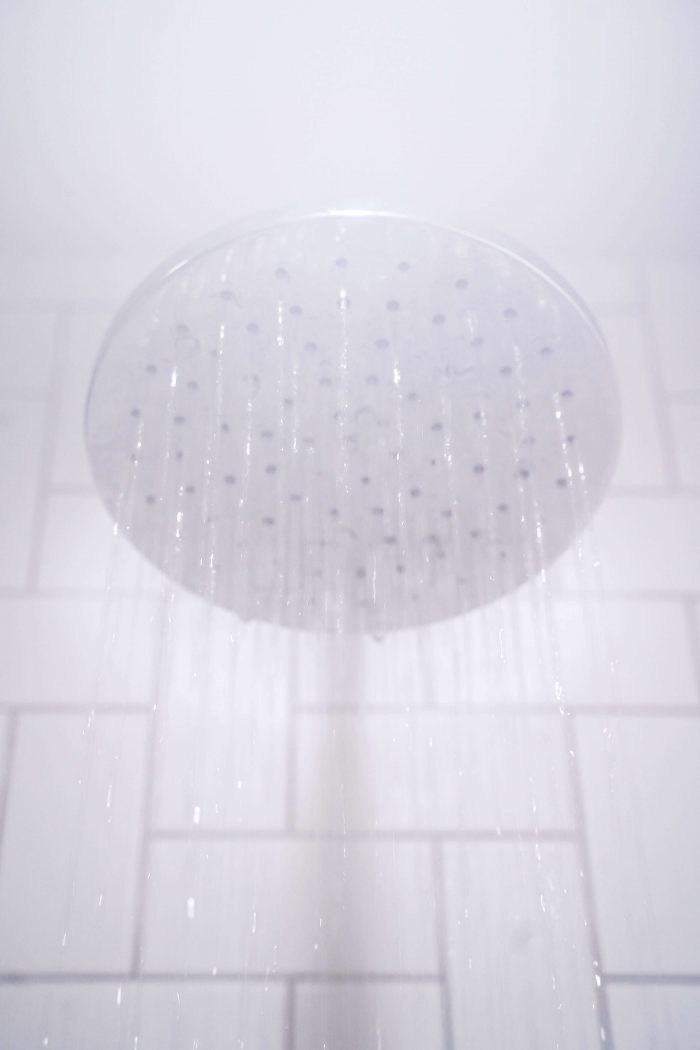
A shower water filter can remove contaminants which cause staining, like iron oxide. These types of contaminants can stain your clothes, skin, and shower cubicle. They also make showering a less pleasant experience.
8. Less Scale
Filters containing KDF 55, can reduce scale accumulation in you shower. They work by changing the structure of calcium and magnesium particles, reducing the number of particles that harden on your taps, bath, and shower screens.
If scale is a problem in your area, installing a new shower water filter could help you avoid many hours of work cleaning your shower attachments and shower screens
9. Better Smelling Water
Filters that contain KDF can even improve the smell of your water in certain circumstances. It can reduce the rotten egg smell that occurs when water has high levels of hydrogen sulphide. This is useful for people living in places like Western Australia, where hydrogen sulphide is usually high.
10. Breathe Easier
There is a demonstrated link between chlorine exposure and childhood asthma. Researchers suspect that this is due to chlorine producing a chemical called trichloramine. If your children are showering or bathing in chlorinated water, they may be exposed to this potentially dangerous chemical.
11. You Will Look and Feel Better!
Showering in fresh, clean water is a much better experience than showering in water that is dirty or contaminated with harsh chemicals. It will smell better, taste better, and feel better against your skin. You will begin to look forward to your daily shower.
Over time, you will also see an improvement in your appearance. Because you have less exposure to chlorine, your hair and skin will have more moisture and take on a lustrous appearance. It’s a simple way to improve your appearance!
Considerations When Choosing A Shower Water Filter
Here are some tips for choosing the ideal shower water filter.
Filter Style
The first choice you will need to make when shopping for a shower water filter is the design of your filter. The most common designs are:
Inline Shower Filter
An inline shower water filter attaches to your existing pipework and filters your shower water before it reaches your showerhead.
Most inline shower filters are designed to be screwed into the water outlet on the wall of your shower. The shower arm/head is then screwed into the outlet of the filter. However, some will be attached further up the shower arm, just before the shower head.
Shower Head Filters
This type of filter has filtration media inside of a shower head. It filters your shower water just before it exits the head.
Handheld Shower Filter
Handheld shower water filters are slimline filters which attach to a handheld shower hose. They are designed to be lightweight and compact as the user will be lifting the filter every time they handle their handheld shower attachment.
Each design has certain pros and cons. The most popular option is the inline shower filter, as it allows for a large amount of filtration media without making your shower head heavy or bulky.
Filtration Media Type
This is perhaps the most important decision you will make when choosing a shower water filter. As mentioned earlier, most filters will contain GAC, KDF, Chlorgon, or a combination of those materials.
Some budget shower water filters will mostly contain GAC. Unfortunately, these filters are far less effective than products containing KDF or Chlorgon, as they cannot handle high flow rates or hot temperatures very well.
KDF and Chlorgon are ideal for hot water and won’t significantly reduce your water flow. Check the filter’s packaging to learn which materials are included in each filter.
Flow Rate
The design, type of filtration media, amount of filtration media, and the available water pressure will determine the flow rate you receive from your shower filter. Inline shower filters using KDF and Chlorgon tend to deliver the best flow rates. Flow rates will not be greatly affected unless the filter is clogged with sediment or has been left in over its service life.
Longevity
The amount of filtration media and the quality of your water will determine the lifespan of your filters. Smaller slimline filters tend to have shorter lifespan compared to larger inline filters. So, a slim filter for a handheld shower might only remain effective for 3 months, while a large capacity high output inline filter could be useful for up to 12 months.
Aesthetics
The appearance of your shower filter is another important consideration to keep in mind. Shower filters come in a wide range of shapes, sizes and colours. If you have stainless steel shower head, you may prefer to use a stainless steel filter housing like the Sprite Solid Brass Chrome Plated Shower Filter. If you have a white shower head, there are also white options available like the Omnifilter Shower Soft SF100 Shower Filter System.
Budget
The price of shower water filters can range from $30 through to $200. High-quality, high output KDF/Chlorgon filters tend to cost around $110 for the filter and inline housing. You would need to pay about $50 per year for replacement filters.
Smaller inline KDF filters for handheld showers are usually cheaper, going for between $50-60, with replacement filters costing around $50. However, the small size of the filters means they need to be replaced more frequently, which makes the handheld option more expensive in the long run, when compared to an inline filter.
The Most Popular Shower Water Filters In Australia
Here are our three most popular shower water filter options:
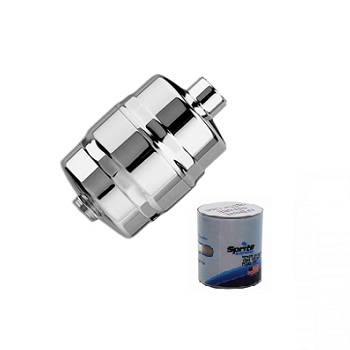
1. Sprite Solid Brass Chrome Plated High Output Shower Filter
Sprite is one of the market leaders in the shower water filter sector. They produce several high-quality products, but their best-selling filter is their Solid Brass Chrome High Output Shower Filter.
It is an inline filter with a 1/2″ female inlet which can screw directly onto the water outlet on the wall in your shower. Your shower arm then screws into the outlet of the filter.
The high output inline type can also be used in some cases on a hand held or hose type shower head by connecting the filter to the wall and attaching the hose on the outlet of the filter.
The filter cartridge contains a mixture of KDF 55 and Sprite’s proprietary ‘Chlorgon’ filtration media. This combination can reduce chlorine, chloramines, trihalomethanes, hydrogen sulphide (rotten egg smell), iron oxides, dirt, sediment and odours.
KDF/Chlorgon will even help to balance the pH of your shower water, which can reduce staining. It also provides a small amount of scale reduction, which is useful in areas with hard water.
Replacing the filter cartridge is simple. All you need you need to do is turn the outer casing counter clockwise and insert your new filter.
The internal filter cartridge can be turned around to backflush sediment which increases the effectiveness of the filter.
The Sprite high output filter housing can be opened and have an internal replaceable filter cartridge. Recommended maximum service life of the cartridge is 12 months depending on the water quality. This is much higher than most filtered shower heads (where the filter is a part of the shower head itself).
Chrome filter casing is 120mm including the threads and 70mm diameter. 1/2″ female inlet and 1/2″ Male outlet. Filters should be replaced annually.
A swivel attachment can be purchased which makes it easier to fit the filter in installations where the male outlet is very close to the wall.
Click here to take a look at the Sprite Solid Brass Chrome Plated High Output Shower Filter
Bath filters are excellent for sensitive skin especially for younger children and babies when bathing. Check out the Bath filter with spout.
There is also a slimline version of this filter with a Chrome filter casing is 90mm including the threads and 85mm diameter. 1/2″ female inlet and 1/2″ Male outlet. Click here to view the Sprite Slimline Shower Filter.
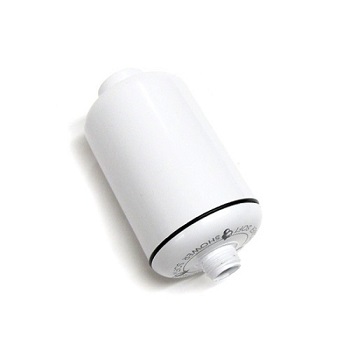
2. Omnifilter Shower Soft SF100 Shower Filter System
The Omnifilter Shower Soft SF100 Shower Water Filter is a simple-to-use product which can effectively reduce many contaminants.
It uses KDF as its main filtration media, which can reduce chlorine, chloramines, trihalomethanes, water soluble heavy metals, scale, bacteria and algae – even in hot water. The SF100 also softens the water which makes showering a more enjoyable experience.
Installation is as simple as unscrewing your shower arm, attaching the filter and then reattaching the shower arm. The Omnifilter SF100 has standard ½” inlet and outlet connectors which means it can be installed in virtually any shower.
This filter is rated at 10 microns and has an effective flow rate of 9.5 litres per minute. The estimated filter life is 113,562 litres or 1 Year. The only downside of the SF100 is that it is sealed and non-refillable. This means entire filter is discarded after 12 months.
The Omnifilter SF100 measures 127mm x 70mm. The filter can be turned around using the ½” socket supplied to back flush the filter every 3 months or as required to reduce sediment and improve performance.
Check out the Omnifilter Shower Soft SF100 Shower Filter System
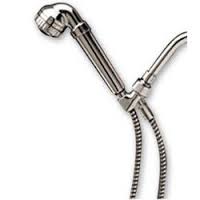
3. Complete Hand Held Sprite Shower Filter with Hose & Rose
Hand held showers have become increasingly popular in the past few years, particularly among families with small children. They make it much easier to clean those hard-to-reach spots and help children enjoy a more comfortable bath time.
One of the most popular handheld options we sell is the Complete Shower Filter with Wall Fitting, Hose & Hand Held Filter with a Shower Rose attached. It is a complete filtration system which simply screws into your existing plumbing.
It features a KDF/Chlorgon filter located in the shower head. This filter can reduce chlorine, chloramines, trihalomethanes, hydrogen sulphide (rotten egg smell), iron oxides, dirt, sediment and odours. It has an effective flow rate of 9 litres per minute.
The Complete Hand Held Sprite Shower Filter comes with a filter, 1800mm hose, and shower head. Filter attachment and hose both have 1/2″ female threads.
Replacement Filters and come in packs of two. Each filter has an estimated lifespan of 3 months.
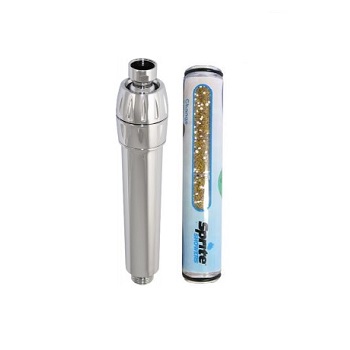
4. Hand Held Sprite Shower Filter Attachment for Hand Held Showers
This simple inline filter is designed to attach to an existing handheld shower setup. It uses the same KDF/Chlorgon filters as the complete kit, which helps neutralise Chlorine in addition to removing hydrogen sulphide (rotten egg smell), iron oxides, dirt, sediment and odours.
It uses the same filter cartridges as the Sprite Complete Hand Held Shower Filter. They are easily installed by unscrewing one end of the filter canister.
Diameter at the widest section is 43mm and overall length is 218mm long. Filter has a 1/2″ female thread at the top and 1/2″ male thread at the bottom. Take a look at the Hand Held Sprite Shower Filter Attachment.
Frequently Asked Questions
Do shower filters work for hard water?
Hard water refers to water which contains a high level of dissolved minerals. Many parts of Australia have hard water, including Western Australia, South Australia, and the Northern Territory.
It is much more difficult for detergents and soaps to create a lather in hard water. This can make having a shower less enjoyable as you have to work harder to clean yourself.
Hard water can also cause scale, as the calcium and magnesium carbonates present in the water harden on the surfaces in your shower.
Shower filters that contain KDF are a great choice for anyone dealing with hard water and scale build-up. KDF helps in two ways.
Firstly, KDF increases the pH of the water slightly, softening it and making it easier for detergents to lather up. Having higher pH also makes scale formation less likely.
Secondly, KDF blocks scale growth steps as the zinc ions in the KDF media cause the precipitation of aragonite from the water. This reduces the amount of calcium carbonate, reducing the level of scale build up.
This makes showers filters containing KDF a wonderful choice for anyone living in a hard water area, like many parts of Western Australia, South Australia, NT, and Queensland.
If you need a scale reducing shower filter, check out the Sprite High Output shower filter, which contains KDF 55 and Chlorgon.
Can shower filters remove fluoride?
The short answer is no, shower filters cannot remove fluoride.
They are ineffective because the types of media normally used to remove fluoride require a lot of contact time with the water.
As the water flowing through a shower filter is moving at a rapid rate, there isn’t enough time for fluoride-reducing media to do its work.
Be sceptical of any shower water filter that claims to remove fluoride — it’s not.
Fortunately, fluoride cannot penetrate your skin very easily. In fact, you can soak your body in high concentrations of fluoride and it will not be absorbed through the skin.
If you are concerned about fluoride exposure, simply avoid drinking water while you are in the shower.
Chemicals like chlorine and chloramines are of much more concern in shower water. A well-made shower filter like the Sprite High Output Shower Filter will dramatically reduce those chemicals and soften the water slightly.
What kinds of skin conditions can shower filters help with?
Shower filters can be beneficial for reducing flareups of many conditions that affect the skin. This includes common problems like eczema and rosacea.
Will a shower filter improve my hair?
Absolutely. Shower water filters can dramatically reduce the amount of chlorine in your water. This is the chemical primarily responsible for causing dry and brittle hair. Chlorine is also the chemical which can cause blonde hair to develop a greenish tinge.
Are Shower Filters Hard To Install?
No, they are actually quite easy to install. In the case of the Sprite High Output Shower Filter, all you do is unscrew your shower arm, attach the filter to the 1/2″ male outlet on the wall and re-attach your shower arm. It could be much easier.
The handheld shower filters are just as easy. After detaching your handheld shower attachment, you’ll screw on the handheld filter housing and re-attach the handheld attachment.
Thread tape can be used, but it may not be necessary.
Are Shower Water Filters Safe?
Absolutely. Shower water filters don’t add anything to the water, they simply reduce contaminants like chlorine, chloramines, bad tastes/odours, heavy metals, calcium carbonates and so on. All of the media used in high-quality shower filters, like the Sprite products, is non-toxic and inert.
Will A Shower Water Filter Slow My Flow Rate?
A shower water filter will have a minimal impact on your shower’s flow rate. In most cases, you will barely notice any changes to your flow rate.
However, if your home has very low water pressure, it can be more noticeable. If you have pressure below 40 PSI, a water shower filter may be unsuitable.
Wrapping Up
As you can see, there are several fantastic options for removing contaminants from shower and bath water. It’s just a matter of finding a solution which matches your personal preferences, budget, and filtration requirements.
If you have any questions or are unsure if you can fit a shower or bath filter just contact us and sent us some pictures and we will be able to advise you.
Clarence Water Filters Pty Ltd
Phone: 02 6646 8565
Email: sales@clarencewaterfilters.com.au
Tags: Bath, Chlorgon, KDF, KDF55, Shower, Shower Water Filters
Categorised in: Buyer's Guides, Shower Water Filters
This post was written by Paul
